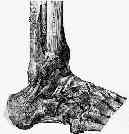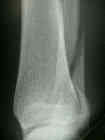- Discussion:

- anterior tibiofibular ligament disruption;
- frx of fibula by external rotation or abduction injury is often preceded by rupture of anterior tibiofibular ligament;
- according to Lauge-Hansen (1950), this ligament injury (or an eqivalent frx) always proceeds frx of the fibula;
- according to Schaffer and Manoli (1987), only 2 of 24 ankles had such an injury;
- anterior syndesmosis is injured with either ligament rupture or there may be avulsion of the anterior portion of fibula (Wagstaffe's fracture) or the anterior tubercle of the tibia (Tillaux);
- anterior syndesmotic ligament are partially or completely torn in about 50% of type B injuries, while posterior syndesmosis ligaments usually remain attached to the posterior aspect of distal fibular fragment;
- Fractures of the Ankle. II. Combine experimental surgical and experimental-roentgenologic investigations.
- The antiglide plate for distal fibular fixation. A biomechanical comparison with fixation with a lateral plate
- spiral oblique fibular fracture: (SER II)
- external rotation produces a spiral fibular frx, which begins distally from anteromedial position & spirals in posterolaterally;
- on lateral x-rays, look for the posterior spike on the distal fragment;
- frx may begin either below, at, or above attachment site of anterior tibiofibular ligament on anterior tubercle of the fibula;
- posterior injury: (SER III)
- when lateral malleolus is displaced, posterior tibiofibular ligament either ruptures or avulses posterior tibial tubercle from back of fibular notch;
- see posterior malleolar frx;
- rotation of talus places tension on posterior syndesmosis, causing rupture of posterior tibiofibular ligament or, more commonly, avulsion of posterior lateral tubercle;
- key to stability of supination external rotation injury is integrity of posterior tibiofibular lig or its bony attachment;
- medial injury: (SER IV)
- finally, there is tension on medial structures, resulting in either avulsion frx of medial malleolus or rupture of deltoid ligament;
- w/ this medial injury, the talus is free to shift laterally
Experimentally produced ankle fractures in autopsy specimens.
The key role of the lateral malleolus in displaced fractures of the ankle.
Examination of the pathologic anatomy of ankle fractures.
Ankle fractures. A clinical and roentgenographic stereophotogrammetric study.

